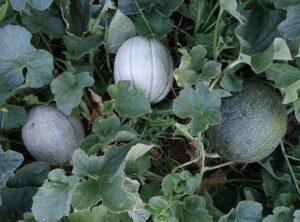Cantaloupe, which is also called the sweet melon, is a variety that belongs to the muskmelon species of the Cucurbitaceae family. People from different countries use different names for this fruit. In Australia and New Zealand, it is rockmelon, while in South Africa, it is called spanspek. Cantaloupe was one of the first plants to be domesticated and cultivated in the world. It also became a commercial crop in the United States around 1890 growing its popularity over the world.
Growing cantaloupe is not hard at all!
Like any other plant, it also needs soil, sunlight, and water. Ample sunlight is a necessary factor to grow cantaloupes. The temperature should stay above 50 to 60 degrees Fahrenheit to sow the seeds. The soil should be highly fertile, and you can use compost to give the necessary fertility to the plants. Composted soil can retain water balance its acidity or alkalinity. PH level of soil should be 6.5 to 7.5 to grow this plant. Without that much pH, plants may lose the ability to absorb nutrients from the earth.
Cantaloupe plant stages
There are four stages in cantaloupe plant growth. Planting seeds, young cantaloupes, pollination, and harvesting are those stages. Let us have a look at each stage in more detail.

Seeds
After selecting the perfect weather and space to grow your cantaloupes, get some good cantaloupe seeds. You can plant the seeds in groups. Include two to three in each group. With a space about 2 feet apart, sow the seeds. Plant the seeds about ½ to 1 inch deep. If the seeds get a temperature of about 90 degrees Fahrenheit, seeds may germinate in 3 to 5 days. At 70 degrees Fahrenheit temperature, germination takes about ten days.
When seedlings emerge along with the leaves, select the best plant in each group. It should be the most healthy one with a strong stem and leaves. Remove the rest of the plants from the groups. This way, the best plants get to grow with enough space and nutrients so that you can get a good harvest.

Young cantaloupes
Cantaloupe takes about 8o to 120 days to mature. Moisture, sunlight, and nutrients are the main things the plants need at this stage. As the plants keep gaining height, you can add a layer of straw of chipped bark mulch. These ingredients will retain the ideal soil temperature for the plant, which is about 7 degrees Fahrenheit.
It needs about 1 to 2 inches of water per week so, if there’s no rain, you can water them. Until pollination occurs, the soil should be moist for the plants to grow well. When the main vine reaches about 18 inches, flowers start to develop. Then you can be ready to face the pollination stage of the cantaloupes.
Pollination
For fruits to set, pollination should occur. As we all know, insects like bees and butterflies carry out pollination. They transfer pollen from male flowers to female flowers. Fruits form as a result of this process. So, when flowers start to bloom, there should be enough bees and butterflies to make sure pollination happens in your cantaloupe growth. Specialists estimate 10 to 15 bee visits per fruit is enough for it to form. By planting bee-loving plants, you can attract bees and butterflies to your cantaloupe plants for their successful pollination.
Although many fruits may form in each plant, the success rate for all of them to reach the full-grown state is very low. Usually, one to four fruits in each plant may get a good size to harvest. If some fruit sets later than others, they may inhibit the growth of the earlier fruits. So, you should pay attention to the development of the fruits. Decide which to keep and which to retain. That way, you can get a good harvest.
Harvesting
The final stage of cantaloupe plant growth is harvesting. After 35 to 45 days of flowering, they are ready for harvesting. You can reap the ripe and fully formed fruits in your cantaloupe plants. By tugging the fruit from the vine, you can easily separate them. Every fruit may not ripen at the same time. So, according to the growth of the fruit, you can decide which to harvest first.
How many cantaloupes per plant?
In the family that cantaloupe belongs to, there are many other varieties. Each grows differently than the others. Comparing with different melon types, cantaloupe plants spread only up to three feet high. In general, each plant can produce four to eight fruits. But the average fruit per plant is usually two fruits.
When to harvest cantaloupe?
Before picking up the melons, make sure they are ripe.
There are several remarkable features you can use to identify the best fruits for harvesting as follows:
- The surface netting of the fruit becomes rough and course.
- The color change of the fruit is from green to yellow.
- When considering the curly string tendrils that you can see near the fruits, they become dry, and they turn to brown color.
If you see these things, then your cantaloupes are ready to harvest. You can easily separate them from the vines.
What is the difference between melon and cantaloupe?
We use the word melon to call any fruit in the Cucurbitaceae family, excluding cucumber. Cantaloupe, watermelon, muskmelon, honeydew melon, winter melon, and many other types of melons are generally called melons.
Melon also acts as an adjective. The light pinkish-orange color is called the melon color.
Cantaloupe benefits
Cantaloupe can act as both a fruit and a vegetable. There are many vitamins and minerals in this fruit. One cup of cantaloupe gives you 144 calories and fulfils 6% of your daily serving of fiber.

The following are the top benefits of consuming this amazing fruit.
- Rich in vitamin C that protects cells from damage.
- Provide 12% of daily potassium necessity.
- 100% of the daily need for vitamin A provided by this fruit keep eyes, skin, bones, and immune system healthy.
- Phytonutrients in this fruit have anti-inflammatory properties that help to fight diseases.
- 90% of the fruit contains water which helps to hydrate you.
- Minerals and electrolytes in cantaloupe balance body fluids and keep it working right.
Apart from these benefits, cantaloupes provide you with the following vitamins and minerals.
- Folic acid
- Calcium
- Copper
- Iron
- Zinc

- Vitamin K
- Selenium
- Niacin
- Choline
- Phosphorus
- Manganese
- Magnesium

